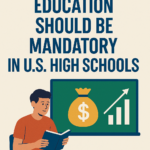Introduction
In the United States, advanced education has always been praised as a milestone that provides a broad array of professional opportunities. In today’s world, a college degree is as important as the foundational building blocks of a career, a favorable market income, and overall social mobility. Their synergistic interplay forms a college graduate’s social network and market perception. So much so that spending in today’s world continues to outpace inflation and wage growth. In turn leading to accumulating debt on students. All this to say, the affordability of higher education across the U.S. is a pressing matter.

The Increasing Expenses of Attending College.
In-state students are charged approximately $11,000 for tuition and fees at public four-year colleges, as reported by the College Board. Out-of-state students incur an additional charge of $28,000 and an average of $39,000 for private colleges. This excludes housing and any college courses taken prior to receiving a degree. Considering all, the cumulative cost for attending college over a span of four years can be easily estimated to surpass $100,000.
What makes attending college so expensive? Here are some contributing factors:
Not state funded: A lot of public colleges are losing funds each year, meaning they have to raise their tuition. This decline in state funding is forcing schools to make cuts, which increases the burden on students.
Bureaucratic expenditure: Budget expenditures have gone up due to an increase in spending on staff that is not directly teaching, for example, instructors and office supplies. This causes a huge dip in the college’s finances.
Campus facilities: Students are being charged for things like posh dorms, high-tech labs, and modern campus infrastructure. A college student’s tuition covers the expenses that the school incurs in order to be competitive.
Hence, with the rise in tuition comes the need for loans. As of 2024, students owe over $1.7 million, which comes to $37,000 per student. There is an impending crisis because the amount is ever increasing.
Loans are perceived as a liability and can create a financial burden. There is an expectation that borrowers are expected to pay loans for a period of 10-30 years for graduates. A lack of funds makes it difficult to buy a house, establish a family, or save for retirement. In the worst-case scenario, a student drops out of college, and this debt starts to pile up with no way to pay it off in the usual standard.
Is College Still Worth It?
Statistically, college is still a financially viable option, despite the expenses associated with it having risen exponentially. According to the U.S. Bureau of Labor Statistics, people holding a bachelor’s degree earn on average over a million dollars over their lifetime more than people without one, so college seems to pay off in the long run at face value. However, ROI also depends on various factors.
Field of Study: Degrees in nursing or engineering tend to yield greater salaries than those in the arts or even computer science.
Institution: Elite, Ivy League colleges can certainly increase the power of a person’s resume but still don’t justify the debt incurred from attending.
Graduation Rate: Students who drop out are left with debt but no diploma and lack the financial benefits that come with it.
A degree has waned in its reliability for guaranteeing financial stability, yet still commands some respect.
How Are Students Coping?
As the costs associated with attaining education continue to climb, students and their families have implemented several coping strategies:
Community Colleges: More and more students seem to be beginning their higher education journey at community colleges.
Part-time Work: It’s widely accepted that students are often employed, which sadly ceases academic performance but boosts financial performance.
Scholarships: These are still the most sought-after form of financial aid, although the growing competition has made it difficult.
Living at Home: Some students have the option of avoiding or minimizing room and board expenses by living with their families and commuting to school.
Many students, however, continue to face financial barriers despite meticulous planning and forecasting.
Policy Suggestions and their Possible Impact
Policymakers are under increasing pressure to manage the crisis surrounding the affordability of higher education. Recommendations include:
Tuition-free community colleges: A handful of states and cities have initiated free access programs for two-year colleges.
Loan forgiveness: Programs such as Public Service Loan Forgiveness (PSLF) have been designed to forgive debt for specific employment sectors, but many borrowers encounter challenges during the application process.
Income-driven repayment plans: These entrust the setting of monthly payments to the borrower’s income, allowing for more flexible payments for recent graduates.
Enhanced funding of public education: Some reserved and politically sensitive views suggest that restoring cuts in state and federal aid—previously used to control tuition price inflation—would effectively contain the negative trend in rising tuition fees.
These reforms require funding and careful re-evaluation of the current strategy for providing and receiving public and private support for education and, therefore, investment to tackle the crisis directly.
Conclusion
As observed, the increasing cost of college in the U.S. poses a dire challenge to the equality and distribution of educational opportunities. The spiraling financial outlay associated with obtaining a college degree is becoming increasingly hard to rationalize, even as a degree continues to offer substantial value in upward economic mobility. To restore the dream, students have to be able to receive sufficient aid, and the system has to be changed. Until then, the dilemma is: Is higher education really affordable for students, or is the cost bound to surpass the benefit?

SEO expert with a passion for optimizing websites and driving organic traffic through data-driven strategies.



